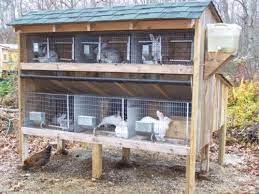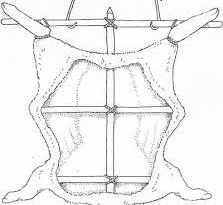Rabbit Housing and Its Equipment
Rabbit housing (hutches and cages) and equipment differ from country to country. Factors governing their design include climate, availability and cost of raw materials, scale and system of production and the expertise of the rabbit keeper.
There are, however, some basic requirements which all hutches and equipment should satisfy and any new or existing hutches and equipment should be assessed against these requirements.
Rabbit Housing Guide
1. Housing Requirements
Any rabbit hutch should provide adequate space and protection for the rabbit and also convenience to the rabbit keeper.
2. Space
Since the rabbit is going to be in the hutch for life there is need to provide enough space to minimize restriction of movement.
For the rabbit to be able to stretch itself and carry out its normal activities then horizontal and vertical space are all important.
Space is also critical for good ventilation and temperature regulation within the hutch. These are necessary to maintain good health and prevent diseases.
3. Protection
For the farmer to be successful, it is necessary to provide adequate protection to his rabbits.
This protection is against injury within the hutch, from direct sunlight, rain, direct and indirect wind, sudden noises, predators like dogs, cats, rats, snakes, safari ants and human thieves.
4. Convenience to the Rabbit Keeper
For a successful operation on the farm, the house should be designed in such away to assist the keeper to carry out routine practices like observation, examination, handling, feeding, mating the rabbits, cleaning and disinfection. Also there should be room for expansion when the number multiplies.
Types of Rabbit Housing
Basically there are two types of housing these are:
Outdoor hutches: These are kept outside all the time.
Indoor hutches: These are kept inside a house or open shed.
Outdoor hutches and indoor hutches.
The requirements of space, protection and ease of management can be achieved through appropriate design, construction and siting.
Typical hutch dimensions for a general purpose hutch are as follows:
1 m above the ground approximately.
Height of hutch: 60 cm at the front, 50 cm at the back.
Width: 50-60 cm.
Length: 90-120 cm.
1. Indoor Hutches
The hutches within the house can be much simpler than outdoor hutches and simple boxes made from wired frames can be used.
These can be hung in a number of ways Indoor hutches are appropriate for the established keeper with good markets to justify the expenses in setting them up. Indoor hutches provide good conditions for the Rabbits and the rabbit keeper.
Also rabbits are more easily observed. Individual hutches are easier to keep clean and use particularly useful where many rabbits are kept. It is easier to protect rabbits from predators. Requires a major initial investment which makes it too costly for the beginner
2. Outdoor Rabbit Hutch
The outdoor rabbit hutch is relatively cheap to set up. It is appropriate when starting production but impossible to meet all the protection requirements all the time e.g. in storms.

However, outdoor hutches are often difficult to clean and keep dry and does not allow you to easily increase the number of hutches quickly.
Read Also : Management Practices in Rabbit Husbandry
Floor Methods of Housing
This method involves keeping the rabbits on the ground, in a fenced area provided with simple boxes for shelter. In this system several does are kept in the same area.
This method is particularly suited to very dry areas and or where producers cannot obtain or afford the materials to build proper hutches. In this method one of the most important requirements is to keep the floor dry.
An alternative method is to make a deep layer of dried straw, rice husks or wood shavings. Mud or wooden shelters that can be secured at night can be constructed to provide protection from predators.
Rabbits may be allowed to burrow in floor system and may rear their young in these burrows, but kindling boxes are preferable. Bucks should be kept separate from the does and young rabbits unless there is plenty of space.
To avoid fighting between does provide enough space at least 1m2 per doe. For floor methods to be successful, observe strict hygiene and avoid overcrowding. This method of rabbit keeping is not widely practiced and need a lot of management attention to be successful.
Hutch Equipment
Hutch equipment consist of the four following items: the Water trough, the Food trough, the Roughage rack, and the Kindling box.
In addition, there may be need for a transport box and a storage facility for food and other items.
Equipment Requirements
For water and food troughs, the requirements are:
It should be impossible to tilt over.
It should have adequate size and depth.
It should discourage scratching out of contents.
It must not cause injury to the rabbit.
It should be cheap and can be constructed locally.
Forage racks
It should be fitted inside the hutch and allow the rabbit full access and not limit food intake.
Kindling boxes should:
Provide a secure, draught proof dry container in which the doe can kindle.
Prevent the young rabbits from leaving until they are at least 2-3 weeks old.
Maintenance of Hutches and Equipment
Hutches need proper maintenance. Regardless of the type of housing method and the equipment used the following requirements on housing and equipment have to be met.
Clean the hutch and equipment every two to three days.
Complete cleaning between litters using soap and water and if possible disinfectants. This should be followed by complete drying and disinfection in direct sunlight.
Checking and repairing loose boards, tins or wires which may allow the rabbits to escape or drop through or predators to enter.
Checking for the development of sharp edges in hutches and on equipment which may cause injury.
This article covered the requirements for designing a rabbit house, the different types of house, equipment needed and their requirements and you have learnt the maintenance of hutches and equipment used.
You have also learnt that any rabbit hutch should provide adequate space and protection for the rabbit and also convenience to the rabbit keeper. Basically there are two types of housing these are outdoor hutches and indoor hutches.
Hutch equipment consist of four items, water trough; food trough; roughage rack; kindling box.
Maintenance of hutches and equipment include cleaning of hutch and equipment every two to three days; complete cleaning between litters using soap and water and if possible disinfectants.
This should be followed by complete drying and disinfection in direct sunlight, checking and repairing loose boards, tins or wires which may allow the rabbits to escape or drop through o predators to enter; checking for the development of sharp edges in hutches and on equipment which may cause injury.
Read Also : Importance and Uses of Sanitation Towel Holder









